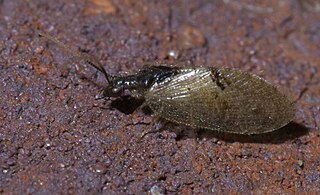
Cephalanthus occidentalis is a species of flowering plant in the family Rubiaceae, that is native to eastern and southern North America. Common names include buttonbush, common buttonbush, button-willow and honey-bells.

Tricimba is a genus of frit flies in the family Chloropidae. There are about 7 described species in Tricimba.

Hemerobius is a genus of lacewings in the family Hemerobiidae. It is found throughout Europe and North America. Like most lacewings, both the larvae and adults are predatory, primarily eating acarines, scale insects, psyllids, aphids, thrips, and the eggs of lepidopterans and whiteflies.

Sympherobius is a genus of brown lacewings in the family Hemerobiidae. There are at least 50 described species in Sympherobius.
Euxoa occidentalis is a species of cutworm or dart moth in the family Noctuidae. It was described by J. Donald Lafontaine and J.R. Byers in 1982 and is found in North America.
Clusia occidentalis is a species of fly in the family Clusiidae.

Pero occidentalis, the western pero, is a species of geometrid moth in the family Geometridae. It was described by George Duryea Hulst in 1896 and is found in North America.

Capnobotes is a North-American genus of shield-backed katydids in the family Tettigoniidae. There are about 9 described species in Capnobotes.

Nostima is a genus of shore flies in the family Ephydridae. There are about 9 described species in Nostima.

Proctacanthus is a genus of robber flies. There are about 18 described species in Proctacanthus.
Microtes occidentalis, the little buzzer grasshopper, is a species of band-winged grasshopper in the family Acrididae. It is found in North America.
Microtes is a genus of band-winged grasshoppers in the family Acrididae. There are at least 3 described species in Microtes.

Clusia is a genus of flies in the family Clusiidae. There are about 12 described species in Clusia.

Lomamyia is a genus of beaded lacewings in the family Berothidae. There are about 11 described species in Lomamyia.
Astata occidentalis is a species of wasp in the family Crabronidae. It is found in Central America and North America.

Orasema occidentalis is a species of chalcid wasp in the family Eucharitidae.

Orussus is a genus of parasitic wood wasps in the family Orussidae. There are about 11 described species in Orussus.
Sympherobius californicus is a species of brown lacewing in the family Hemerobiidae. It is found in Central America, North America, and Oceania. The species was introduced to New Zealand to prey on aphids and mealybugs affecting crops, first noted in 1936, however was not able to be established.

Sympherobius barberi, or Barber's brown lacewing, is a species of brown lacewing in the family Hemerobiidae. It is found in Europe & Northern Asia, Central America, North America, Oceania, and South America. The species was introduced to New Zealand to prey on aphids and mealybugs, first noted in 1936, however was not able to be established.
Sympherobius killingtoni is a species of brown lacewing in the family Hemerobiidae. It is found in Central America and North America.












